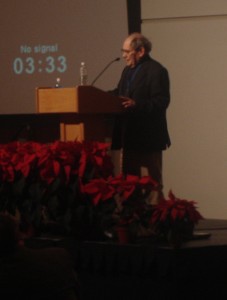Sydney Brenner, The Salk Institute
"What is a Gene"

Sydney Brenner has been called "the Thomas Jefferson of molecular biology," with good reason.
Much of his talk described the hurdles that the pioneers of genome sequencing had to overcome. It is hard to grasp the progress this field has made in merely 50 years since the double helix. In the beginning, when they met to discuss the sequencing of the human genome, they only had the phage lambda, which was ~40,000 bp. They were planning 3 billion! It was an enormous task. But they accomplished it by adhering to standards such as keeping no data in the database that's not CAP: complete, accurate, paramount.
He discussed genomics as a lesson in science. Now we see -omics as a copy of the approach to genome sequencing: getting massive, rich, digital data. Get things you can count. It fits the CAP rule!
In illustrating genomic complexity, he explained that there are on average 5 different gene instantiations for each locus. Additional complexity comes from different cell types, which are abundant in the brain.
Some controversy: he thinks whole concept of systems biology is wrong. Instead, he supports the mantra “Least is Best,” i.e. quality and directed experiments are better. To paraphrase, "You don’t learn to play the drums by listening, you go in there and learn the notes."
He appeared weary of the biotechnology business, calling the two greatest evils 1) venture capitalists and 2) the CEOs of those venture capital companies. He went on to say, “The only thing worse than scientists doing business is businessmen doing science."


4 Comments:
I think it is cool that we have beaten the aero people in speed of progress. It took them 66 years to get from the first flight (Wright brothers, 1903) to the moon (1969). But we have gotten from the double helix (1953) to the sequence of the human genome (2003) in only 50 years.
Its interesting but totally different levels of difficulty. The space shuttle is the most complicated machine ever built by man. So i wouldnt say that 'we' are beating 'them'
Yeah, I know these aren't actually comparable things. But I don't think that the space shuttle's complexity makes it a more difficult achievement, either.
And where are the live pictures from this talk?!
Oh my god, there's a lot of useful info in this post!
Post a Comment
<< Home